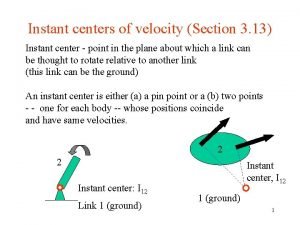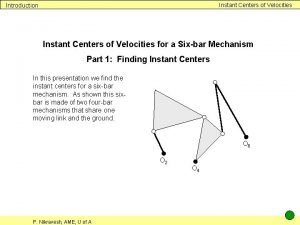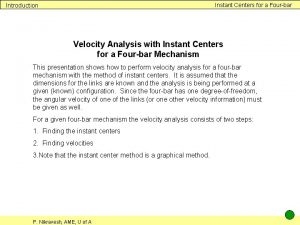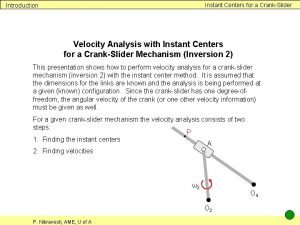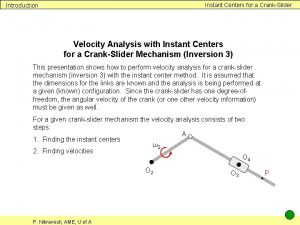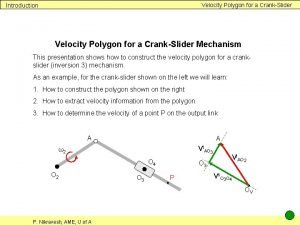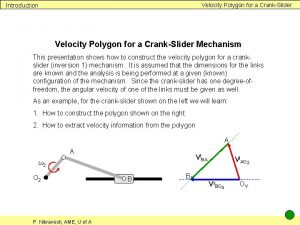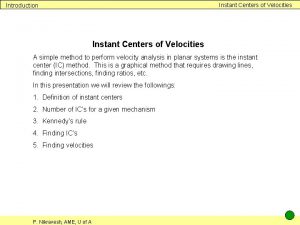Instant Centers for a CrankSlider Introduction Velocity Analysis







- Slides: 7

Instant Centers for a Crank-Slider Introduction Velocity Analysis with Instant Centers for a Crank-Slider Mechanism (Inversion 1) This presentation shows how to perform velocity analysis for a crank-slider mechanism (inversion 1) with the instant center method. It is assumed that the dimensions for the links are known and the analysis is being performed at a given (known) configuration. Since the crank-slider has one degree-offreedom, the angular velocity of the crank (or one other velocity information) must be given as well. For a given crank-slider mechanism the velocity analysis consists of two steps: 1. Finding the instant centers 2. Finding velocities A ω2 O 2 P. Nikravesh, AME, U of A B

Crank-slider mechanism (inversion 1) Instant Centers for a Crank-Slider Crank-slider mechanism Assume that for this crank-slider mechanism all the link lengths are known and the angular velocity of the crank is given as ω2 ccw. In the configuration shown we can perform a velocity analysis with the instant center method. A ω2 O 2 P. Nikravesh, AME, U of A B

Number of instant centers Instant Centers for a Crank-Slider Number of instant centers The first task is to determine how many instant centers exist for a crank-slider. The number of links in a crank-slider is A (2) n=4 Between n links, there are n (n − 1) ∕ 2 (3) B (4) O 2 (1) instant centers. That means in a fourbar there are 4 (4 − 1) ∕ 2 = 6 instant centers. A small circle will help us keep track of locating each center. On the circumference of the circle we put as many marks as the number of links. ► Each time we find a center between two links, we draw a line between the corresponding marks on the circle. P. Nikravesh, AME, U of A 1 2 4 3

Finding the instant centers Instant Centers for a Crank-Slider I 1, 3 Finding the instant centers Four of the centers are already known: They are three pin joints and the sliding joint. ► Note: The instant center between two bodies connected by a slider is located in infinity on any axis perpendicular to the axis of sliding. We don’t know I 1, 3 but we know that it lies on the same line as I 4, 1 and I 3, 4. ► I 1, 3 also lies on the same line as I 1, 2 and I 2, 3. ► The point of intersection is I 1, 3. ► I 2, 4 is also unknown but it lies on the same line as I 3, 4 and I 2, 3. ► I 2, 4 also lies on the same line as I 4, 1 and I 1, 2. ► The point of intersection is I 2, 4. ► Now we have found all 6 centers. P. Nikravesh, AME, U of A I 2, 4 = I 4, 1 A = I 2, 3 (3) (2) B = I 3, 4 O 2 = I 1, 2 (1) (4) 1 2 4 3

Finding ω3, knowing ω2 Instant Centers for a Crank-Slider Finding velocities I 1, 3 A (or I 2, 3) is a point on link 2, therefore: RAI 1, 3 VA = ω2 ∙ RAI 1, 2 Its direction is obtained by rotating RAI 1, 2 90° in the direction of ω2. ► A (or I 2, 3) is also a point on link 3, which rotates around I 1, 3. This means: VA = ω3 ∙ RAI 1, 3 Since we already know VA, we can solve for ω3: ω3 = VA ∕ RAI 1, 3 P. Nikravesh, AME, U of A ► VA A = I 2, 3 ω3 ω2 I 1, 2 RAI 1, 2

Finding VB, knowing ω3 Instant Centers for a Crank-Slider Finding velocities I 1, 3 Since we have found ω3, we can now find VB. B is a point on link 3: VB = ω3 ∙ RBI 1, 3 Its direction is obtained by rotating RBI 1, 3 90° in the direction of ω3. ► B is also a point on link 4. Therefore, the velocity of the slider block is the same as VB. ► P. Nikravesh, AME, U of A RBI 1, 3 ω3 VB B

Finding VB, knowing ω2 Instant Centers for a Crank-Slider Another approach We could have determined VB without knowing ω3: = I 4, 1 I 2, 4 is a point on link 2, therefore: VI 2, 4 = ω2 ∙ RI 2, 4 I 1, 2 Its direction is obtained by rotating RI 2, 4 I 1, 2 90° in the direction of ω2. ► I 2, 4 is also a point on link 4 which rotates around I 4, 1 located in infinity; i. e. , link 4 does not rotate. This means any point on link 4 has the same velocity as VI 2, 4. ► P. Nikravesh, AME, U of A VI 2, 4 RI 2, 4 I 1, 2 B ω2 I 1, 2 VB
